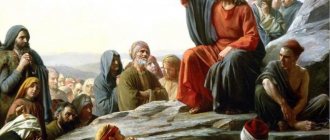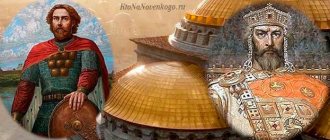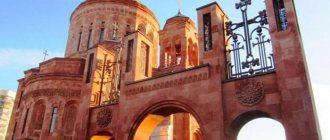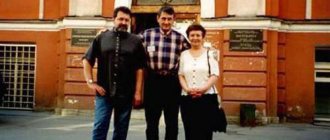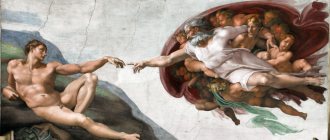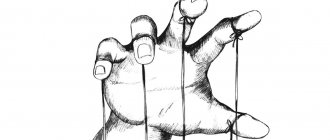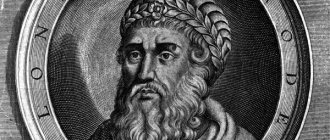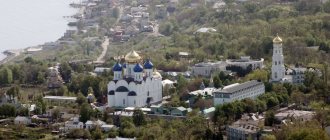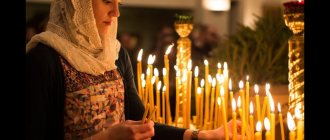A few more short facts about Christianity
- The first state to adopt Christianity as the official religion of the country was Armenia .
- Africans who profess Christianity believe that Jesus was a black man.
- It is believed that Jesus had brown eyes, like the vast majority of Jews.
- The Bible makes no mention of the date of Christ's birth.
- Previously, communion with wine in Catholicism was the privilege of the spiritual elite.
- Christianity is the only religion that allows you to eat any food except during fasting.
- It is believed that Christ had brothers and sisters.
- In the Philippines, people are crucified so that they feel his torment. The action is voluntary.
- In the scripture, Prince Joasaph became not the founder of the Buddhist faith, but a Christian.
- The first Russian mathematician Kirik was a monk.
- The Catholic Patriotic Association of China does not obey the Pope.
- Japan became a closed country due to the Christian uprising . The samurai eradicated all the rebels and closed the borders.
- There is a Christian temple in Antarctica.
- You cannot pray in front of a damaged icon.
- In pre-revolutionary Russia, information about birth and death was found exclusively in the church.
How Church Customs Provoked Mass Murders of Innocents
According to Christian beliefs, suicide is a great sin . Those who take such a step will go to Hell. In order to avoid punishment, people killed innocents and then voluntarily surrendered. The penalty for murder was death. If a person realized his bad deeds before his death, then he went to Heaven. Such a loophole provoked frequent wanton killings. Governments have abandoned executions to solve the problem of lawlessness. Instead, life imprisonment and hard physical labor were introduced.
Jesus
A Christian cannot be an anti-Semite, because Christ was a Jew, all the apostles were Jews. Those who say that Jesus was not a Jew, or that Jesus had no nationality, are wrong. After all, Christ was a man, and every person has a nationality. Jesus performed religious rituals that Jews were required to perform under the Old Testament, which means he was both a Jew and a Jew (Judaism is a religion). Christ's mother Mary was a Jew, and among Jews, nationality is passed on through the mother.
Jesus was sinless. But Christ was subjected to numerous temptations, for example during a forty-day fast in the desert. If he was subjected to temptation, then he fully understands people who are also subject to temptation. Why couldn't he, being an ordinary person, sin? Apparently, because of knowledge, he knew the whole universe perfectly, and knew that sin is what will separate him, as a person, from the Father. Happiness from being in unity with the Father, deep knowledge that he would become deeply and infinitely unhappy if he sinned, love for the Father made his sin impossible. If a person knew as much as Jesus knew, he would have no desire to sin. After all, life is a moment before endless eternal life. The fact that Jesus did not sin during 33 years of his life is a very strong feat, because he constantly lived under the temptations that an ordinary person has.
Jesus was a Nazarite. These are men in Judaism who dedicated their lives to God, they could not drink wine or eat grape products, and did not cut their hair. Whether Jesus drank wine is unknown, but the miracle of turning water into wine, which occurred in Cana of Galilee, shows that Jesus approved of drinking wine on holidays. Moreover, in the ancient world, wine was added to water not just for taste, but to disinfect the water, because the alcohol contained in wine kills bacteria. Jesus was definitely a very cheerful person who loved to have fun. Since he was sinless, he could not be gloomy and gloomy (sin, as a rule, leads to gloominess), therefore, in order to be cheerful, he did not need wine. A Christian cannot abuse alcohol, but the fact that Jesus had a positive attitude towards moderate alcohol consumption says that everything on Earth was created for the good of man, everything can be beneficial to a person, and everything can be harmful. A small amount of a seemingly harmful substance can be a medicine, and a large amount of such a harmless substance as sugar can be poison. Therefore, a Christian is not a person of extremes, he is a person who, using his sound mind and freedom, can make the right choice in a specific situation (of course, this choice should not contradict Christian teaching).
Jesus may seem like a strange man. And not only in the understanding of the ancient world, but also in the modern one. His high priests (apostles) were not Jewish priests, but simple workers (although, undoubtedly, among the Jewish priests there were many worthy, educated and sincere believers in God). I constantly tried to be in the company not of worthy and good people, but of criminals, murderers, seriously ill, immoral people. Let's imagine that a man who declared himself the Messiah goes to businesses, looks for hard workers to preach his teachings, tries not to visit universities and other gatherings of the intelligentsia, but goes to hospitals, drug dens, thieves' "raspberries" to give unfortunate people hope for a better life. Other preachers, besides Christ, tried to please the rulers (or become rulers themselves), but Christ did not want to please anyone, he just wanted those who were unhappy to become happy, and he, the King of the Universe, understood that happiness is not money and not power, but simply being in unity with the Father.
Jesus Christ was truly extreme - he traveled a lot, did not care about food or a roof over his head. He was not like ordinary people (including modern people), for whom comfort is important. The Christian preachers who came after Christ were also amazing people - they traveled, faced dangers, they could be killed or maimed just because they preached Christianity. And, what is most surprising, all the missionaries knew that they could suffer martyrdom for preaching Christianity. Without receiving any material benefits in return, the preachers were ready to endure any hardships, but to bring people the message of Christ. Probably the source of this strength was the happiness they held in their hearts, and they wanted to share this happiness with other people. When they gave people hope, they themselves became happier, and this spiritual joy was so strong that it was stronger than any, even the most severe physical suffering.
Jesus taught people how to quickly become happy. He said, “If you want to be perfect, go, sell all your possessions and give to the poor. Then you will have wealth in heaven. And then come and follow Me.” This does not mean at all that we should all lose our property, become poor and wander around the world. This means one thing - many of us live next to things that burden us mentally. For example, for the sake of material wealth, we can temporarily do work that brings us moral suffering. There is no need to waste time on bad things, you need to get rid of them and do something good. After all, there is so much beauty in life, but we can temporarily do what we don’t like, and this “temporary” can last for decades, or even a lifetime. Time is a very valuable and free resource that can be used for good, or it can be ruined, just as the lazy worker ruined his talents in the Parable of the Talents.
Jesus Christ accepted martyrdom. It was one of the hardest, and perhaps the hardest, deaths in human history. Why was this death so hard? He was tortured, he was mocked, he was crucified. The torture was terrible - he was flogged with leather straps, at the ends of which there were lead weights in the form of a small dumbbell. Such an instrument of torture tears human flesh to the bones. They beat Christ and put a wreath with thorns on his head. Death on the cross is very difficult - a person hangs on his hands, which are pierced with nails (and this despite the fact that there are many nerve endings in the hands and palms), the person suffocates, in order to breathe, he needs to get up on his feet and pull himself up on his hands that are nailed down to the tree with nails. Execution on the cross is not only physically painful, it is also very shameful. It is not surprising that during prayer in the Garden of Gethsemane Jesus sweated blood; this phenomenon can also occur in an ordinary person if blood vessels burst from very strong excitement. He did not sin, but apparently learned what the torment of a sinner is, who separated himself from the Lord by sin (remember, the exclamation “My God, My God! Why have you forsaken me?”), perhaps it was at that moment that he took upon himself all the sins of the world. After death, Jesus descended into hell, he perfectly understood what the torments of hell are. Therefore, God, having become a man, went through all the possible suffering that a person has. Jesus is still in heaven in a human body. Christ is now is a person. He understands people perfectly, he is always ready to help. We must not forget that everything in our lives is fixable as long as we are alive. No matter how seriously we sin, no matter how terrible people we are, we can do it at every moment. turn to Christ, who understands us, is ready to forgive and help.
Jesus Christ failed as a man. Yes, it was a complete loss. He was killed and disowned by everyone except his mother. Nobody helped him; he was completely alone. But he won as God. We must not forget that while we win in this life, we often lose. After all, while making a career, earning money, we often do the wrong thing - we give bribes, buy positions. We can achieve a good position in society, we can become rich, but when we reach the top (become a millionaire, a major official), we will definitely feel emptiness. Time cannot be returned, money does not bring happiness. You can’t eat twice as much, sit on two chairs, and wear four pairs of boots. You cannot live according to the principle “today I will sin and get what I need, and tomorrow I will repent.” Anything acquired through dishonest means will not bring happiness. And man was born for happiness, the Lord created man so that he would have someone with whom to share the joy of his eternal and happy existence. Therefore, we need to live honestly, even if this honest life does not lead us to material well-being - this is the only path to true happiness.
About Jesus Christ, despite the fact that much is said about him in the Gospel, many scientific works have been written, there is still much we do not know. And this does not mean at all that we should look for alternative versions of God who became man. All reliable information is given to us by the Christian Church - Catholic and Orthodox. But it is one thing to read about a person, to hear about him from other people, and quite another to be personally acquainted with him. Jesus Christ not only once lived, he is not just somewhere in heaven. He is always near us. He is knocking on our heart, and when we let him in, he will not just be God, he will be our best friend, brother, adviser and dearest person. For this you need very little - you just need to want it. And then you need to come to church, confess and take communion (if you are unbaptized, you must first be baptized). The greatest gift in the world is to have true happiness by being with God, completely free.
Jerusalem syndrome - the world's first religious disease
The word disease in this case is by no means symbolic. People with Jerusalem syndrome suffer from a nervous disorder in which they strive to completely repeat the life path of their spiritual mentor. It is not only Christians who suffer from it. It’s just that for the first time such behavior was recorded in a pilgrim who was on his way to Jerusalem. This was the reason for this name, by the way.
Shroud of Turin
Christianity is, first of all, faith. But there is irrefutable material evidence that Jesus lived, was tortured, was crucified, and was resurrected. Jesus left us behind the Shroud, which is now in the city of Turin to read; detailed information about it can be read in Ukrainian on the website www.shroud.com.ua. Only non-believers need proof; Christians have faith deep in their hearts. Christianity would exist even if the Shroud did not exist. But the burial shroud of Jesus Christ has been preserved, it testifies that everything that is said in the Gospel is true, which is why this relic is called the fifth Gospel.
- The history of the Shroud can be traced from the crucifixion of Jesus to the present day. It was known in Byzantium as the Mandylion and was kept in Constantinople. After the capture of Constantinople by the Crusaders in 1204, it ended up in Europe, now kept in Turin, Italy.
- The image on the canvas does not look like a painting, it looks like a detailed photograph (but is not a photograph either). The smallest details are visible on it - flowers, letters from a coin that was placed over the eyes of the deceased. The image is formed by the dehydration of surface fibers, which have changed their color to a thickness of several microns (there is no image on the reverse side of the canvas). The image is so clear and detailed that pathologists can study it as they would study a deceased person.
- The man depicted on the Shroud died on the cross; before that he was tortured. Scourging and beatings are described in the Gospel. It could have been someone else who was executed according to Roman customs. But one detail indicates that this person is Jesus Christ - a crown of thorns on his head.
- In 1988, radiocarbon dating of the canvas was carried out, according to which the relic was dated to the 14th century. But we are dealing with an image that arose as a result of radiation unknown to science (it could have been left by a flash of light that Roman soldiers saw at the moment of resurrection). From this flash, an image of the body was formed on the canvas, as well as flowers and coins that were on the buried person at the time of the Resurrection. So it is unlikely that the radiocarbon dating method is applicable to this painting (there are other reasons why the radiocarbon dating of this relic could be inaccurate).
- Pollen from 58 plant species was found on the Shroud, of which 44 plants grow in the Middle Eastern region (Egypt, Palestine), 32 of them self-polust, and therefore cannot be carried over long distances, 13 are characteristic or endemic to Palestine. A third of the pollen comes from the plant Guindelia tournefortii, which is endemic to the Middle East and blooms in Israel in the spring. Scientists suggest that it was from this plant that the crown of thorns was made. There are 28 species of plants on the Shroud, all of which grow in Israel. Traces of aloe and myrrh were also found on the canvas; they were used in ancient funeral rites. Archaeologists have confirmed the practice of using flowers and plants at funerals in Palestine in the 1st century AD.
- Red spots are formed by human blood, blood type AB.
- The Shroud of Turin has some of the properties of a photograph. The Shroud first caused a sensation in the scientific community after an Italian photographer took a photograph of the Shroud in 1898. While developing the film, he realized that the image on the Shroud was a negative, since a photograph that should have been a negative was developing as a clear positive photograph. But the canvas is not a photograph - the image has three-dimensional information - areas of the body that were closer to the canvas are darker, more distant areas are lighter. Based on these properties, a three-dimensional image of Jesus was made using a special VP-8 apparatus (which models the earth's topography from satellite images).
- Coins that were issued in 29 - 30 AD were revealed before our eyes. There was an error in the inscription on one of the coins, which numismatists had not yet noticed. Soon this error was also discovered on copies that were kept in private collections. There was one coin on the right eye, two on the left. Images of coins and inscriptions on coins are visible without magnification or computer processing.
- The deceased was tortured with Roman flagrum whips; there were weights in the form of small dumbbells on the leather belts. Such weights were found during excavations in Herculaneum.
- The crown of thorns is made in the form of an oriental cap, as was customary among eastern rulers, and not in the form of a hoop, as was customary in Europe.
- The fabric was made in the Middle East in the 2nd century BC - 1st century AD, it was called “Damascus”. The fabric was very expensive. This material was made from flax but had some cotton in it, a mixture of fibers that was prohibited by the Jewish Law of "Different Kinds" for clothing, but mixed fiber fabric was allowed to be used for funeral shrouds.
- The Shroud of Turin is repeatedly mentioned in historical sources as the Mandylion. Emperor Constantine in the 10th century mentions the Mandylion as a monochrome, fuzzy image that can be seen if you move a few steps away. The image on the Shroud is visible from a distance of seven meters. This property of the image is another proof that the Shroud is not a painting, because to paint such an image, you need to have a brush several meters long. Any attempt by artists to draw a similar image leads to a result that is very distant from the original; it was not possible to create an exact copy through artistic means.
- Traditionally, the Mandylion in iconography is an image of a face, but in the speech of Refendary Gregory on the occasion of the transfer of the Mandylion from Edessa to Constantinople (944), it is said that the Mandylion depicts a wound in the side. Also in Byzantine sources, the Mandylion is referred to as tetradiplon, which means “folded four times.” From the traces of the fire, it can be determined that the Shroud was kept folded several times so that only the face was visible.
Another amazing fact is that using all modern scientific achievements, a person cannot create the same seemingly simple relic as the Shroud of Turin. A man landed on the moon, with the help of an electron microscope he can see an atom, but he cannot forge the Shroud of Turin. If this cannot be done today, how could this relic be made in the ancient world or in medieval times?
In the case of the Shroud of Turin, there is so much evidence that, using ordinary scientific methods, we can say with absolute certainty that the Shroud of Turin is real, that is, it was the funeral shroud of Jesus Christ. In the 1970s, mathematician Bruno Barberis, a professor at the University of Turin, determined the likelihood that the man from the Shroud is not Jesus of Nazareth by identifying only seven common elements of the description from the Bible and what is recorded on the ancient painting:
- after death the body was wrapped in a shroud;
- on the body there are wounds that were formed from the crown of thorns and traces of beatings with whips;
- carrying a heavy object on your shoulders;
- the man was nailed to the cross;
- the right side was pierced after death;
- the legs were not broken;
- the man was wrapped in a shroud immediately after being taken down from the cross and was not washed or embalmed; he remained in the shroud for a short time.
Of these 7 facts, some are quite rare. And if we assume that they can be compared with any other person who was nailed to the cross, we get a probability of one in two hundred billion that the person on the Shroud is not Jesus of Nazareth.
Jesus gave man everything so that he would believe in him - the Christian Church, which preserves traditions, confession so that we can get rid of the burden of sins, communion so that we can heal our soul and body. The weight of one sin is terrible, but Jesus Christ took on all our sins. God became a man so that we could understand him better, performed miracles, resurrected and healed people. He even left irrefutable proof that he existed and was resurrected - the Shroud of Turin. We, like the unbelieving Thomas, can put our hands into his wounds and see what torment he suffered so that we could be happy. It is surprising that there are people who are not yet Christians. Apparently, this is convenient for them - after all, a Christian cannot be a conformist, he is always subject to persecution, even in Christian states. But being a Christian is the only true path in life, and this cannot be denied.
Church
Medieval churches could house anything, even lepers. Special rooms were equipped for lepers, which had a special window - a hagioscope. Through it, people with leprosy could see the liturgy and take communion.
At the turn of the 1st century AD, the Romans conducted a census in Palestine. All residents had to return to the places where they were born. Mary and Joseph lived in Nazareth and had to travel about 150 kilometers to take part in the census.
The Church of the Holy Sepulcher in Jerusalem belongs simultaneously to six Christian denominations - Catholic, Greek Orthodox, Syriac, Coptic, Armenian and Ethiopian.
Anti-Semites often say that the Jews crucified Christ. The Jews did not crucify the Lord, the Romans crucified him. Even the crowd, which consisted of Jews and shouted “Crucify Him,” could not have been more than a few dozen people, because, as archaeologists have found out, Pontius Pilate’s courtyard was very small.
Sometimes Christians are told that you did something bad, sinned, but you call yourself a Christian. A Christian is not sinless, he is just as sinful as any other person. The difference between a Christian and a non-Christian is that a Christian accepts mercy - he can confess and take communion, in this way he is healed of the wounds that sin gives him. Anyone who does not want a merciful attitude towards himself walks around with wounds from sin that do not go away.
All the apostles died a martyr's death except the Apostle John (he wrote the Gospel of John, the Revelation of John the Theologian and three epistles, these writings are part of the Gospel). The Apostle John died of old age, although he lived a hard life; he spent many years in exile on the island of Patmos.
The Apostle Paul was a Roman citizen. His head was cut off, since no other form of execution was used for Roman citizens.
Christianity is a religion not only of faith, but also of action. It is not enough to simply pray and perform church rituals. Work aimed at improving the world around us (this could simply be honest work at one’s workplace), helping one’s neighbor is a contribution not only to society, but also to the Christian Church.
A Christian can consider himself a Christian if he is baptized, attends the Liturgy once a week (preferably on Sunday) and on church holidays, confesses and receives communion at least once a year (for Catholics - at least three times a year). If a person simply comes to bless Easter once a year, unfortunately, he is not a Christian, he is a person who observes Christian traditions.
Christians can engage in missionary work among people of various religions, but not among Jews. After all, the Jews know one God. Christians can only regret that the Jews do not know Christ and their activity may consist in helping these, in fact fellow believers, to perceive Jesus as their Messiah, whose coming the Old Testament prophets spoke of.
